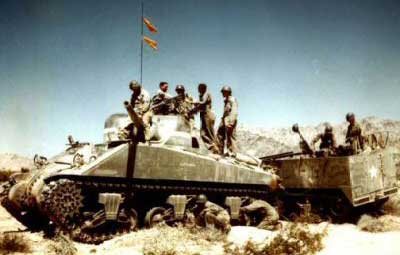-
California/Arizona Maneuver Area (Desert Training Center)
 This was the largest Army base in the world covering some 18,000 square miles. It stretched from the outskirts of Pomona, California eastward to within 50 miles of Phoenix, Arizona, southward to the suburbs of Yuma, Arizona and northward into the southern tip of Nevada. It existed primarily to train U.S. forces in desert warfare for the North African campaign.
This was the largest Army base in the world covering some 18,000 square miles. It stretched from the outskirts of Pomona, California eastward to within 50 miles of Phoenix, Arizona, southward to the suburbs of Yuma, Arizona and northward into the southern tip of Nevada. It existed primarily to train U.S. forces in desert warfare for the North African campaign.
Native Californian Major General George Smith Patton, Jr., commander of the I Armored Corps, was responsible for selecting this site in early 1942. As a native of southern California he knew the area well from his youth and from having participated in Army maneuvers here and in the Mojave Desert in the 1930s. Patton chose the small town of Desert Center, population 19, as his headquarters. At that time the training base was called "Desert Training Center" and had not yet reached it maximum size. Six months later it was given the CAMA name, and by November 1943, it had reached its maximum size after several expansions. Patton and his advanced team designated various locations within the area where tent camps would be built to house individual units. The camps were situated so that each unit could train individually without interfering with the other. Airfields, hospitals, supply depots and sites for other support services were selected as was a corps maneuvering area. The plan was that each division and or major unit would train in its own area, and near the end of its training period would participate in a corps (two divisions or more) exercise in the corps maneuvering area at Palen Pass. Upon completion of the corps exercise, the trained units would leave CAMA, and new units would arrive to begin their training and the process repeated.
The area chosen in the Mojave Desert was ultimately 350 miles wide and 250 miles deep. On 20 June 1942 the War Department acquired the land from the Department of the Interior by Public Land Order No. 1. The area included several sections in Riverside County, ranging from Indio, California to Arizona and from Las Vegas to Yuma. On May 12, 1942, by announcement of General Orders No. 7, the Desert Training Center was named Camp Young. On January 27, 1943, by announcement of General Orders No. 8, Camp Young "proper" (3,279.89 acres) became the Headquarters of the Desert Training Center/California-Arizona Maneuver Area (DTC/CAMA). By November 1943 CAMA had enlarged and included Camp Young, Camp Coxcomb, Camp Iron Mountain, Camp Granite, Camp Essex (later renamed Camp Clipper), Camp Ibis, Camp Hyder, Camp Horn, Camp Laguna, Camp Pilot Knob, Camp Bouse and several bombing and artillery ranges.
CAMA was divided into a Communication Zone and a Combat Zone. The Communications Zone surrounds and entirely encloses the Combat Zone. Those areas within the perimeter of the Communication Zone are not really maneuver areas. Camp Young was located outside the Combat Zone, within the Communication Zone (Desert Area Recreation Survey, Geography of Desert Training Center 1943).
General Patton, who was independently wealthy, purchased some commercial radio broadcasting equipment with his own funds and set up his own radio station within CAMA. The station broadcasted music and news most of the time except when Patton wanted to address the troops. He kept a microphone at his desk and another by his bed and broke into the programming whenever it suited him.
Patton's I Armored Corps trained here from April to August 1942 and then departed to participate in the invasion of North Africa which occurred in November 1942. As Patton and his.troops moved out, the II Armored Corps, under Major General Alvan Gillem, Jr., moved in. They trained at CAMA until October and their place was taken by the IV Armored Corps. They were followed in successive order by the IX Corps, XV Corps, IV Corps and X Corps.
When the Allied victory came in North Africa, the need for desert-trained units faded and in May 1944, CAMA was closed. Most of the sites can be visited, but some are difficult to reach. In most cases the only things that remain at the camp sites are streets, sidewalks, building foundations, patterns of hand-laid rocks for various purposes and trash dumps. Monuments have been erected at some of the camp sites and there are areas within CAMA that are fenced off with danger signs warning of unexploded ordnance. The following is a list of the California elements of CAMA.
- Blythe Army Air Field
- Camp Clipper
- Camp Coxcomb
- Camp Goffs
- Camp Granite
- Camp Iron Mountain
- Camp Ibis
- Desert Center Army Air Field
- Needles Airport
- Camp Ono
- Palen Pass
- Camp Pilot Knob
- Rice Army Air Field
- Camp Rice
- Shavers Army Air Field
- Thermal Army Air Field
- Camp Young